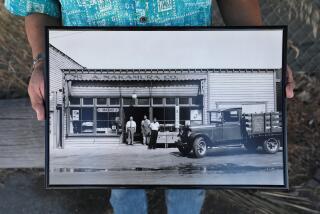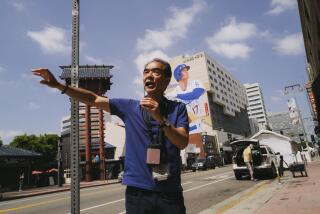Remembering the Heartache of Terminal Island
- Share via
Forced to evacuate his childhood home near San Pedro Bay during World War II, Kenji Yamamoto packed the only valuable possessions he had: his clothing, shoes and a portable radio.
“I had a .22-gauge rifle and took it to the Japanese community hall” where it was confiscated by American soldiers, Yamamoto said. “They said they would give it back, but I never saw that (again.)”
Yamamoto, 76, now lives in Boyle Heights. He was among the last to see Terminal Island as a thriving 3,000-member Japanese community of fishermen, fish-cannery workers and merchants.
Amid rumors that the village on Fish Harbor was a spy colony, American soldiers evicted at gunpoint all people of Japanese descent on Feb. 25, 1942.
In 48 hours, the community was destroyed. Terminal Island was later turned into a military base, and Japanese-owned stores, fishing boats and other property were razed or taken over by outsiders or industrial companies.
Though the island now stands as a slab of landfill in Los Angeles Harbor, Little Tokyo’s Japanese American National Museum for the first time is revisiting the lost community through an exhibit of historic photographs and artifacts.
“An Island In Time: The Terminal Island Story” runs through Nov. 13.
The close-knit group of Terminal Island residents, who still hold reunions around Los Angeles County, formed a campaign committee earlier this year and raised more than $200,000 for the exhibit--twice its $100,000 target, Yamamoto said.
*
Most of the money has gone to pay for labor and equipment costs for the exhibit, which features 70 historic photographs and 40 artifacts, including a model of a Japanese fishing boat, a handmade box containing fishing hooks and bait, newspapers of that period and report cards.
Any remaining money will be used to establish a permanent Terminal Island collection and possibly allow for a traveling show, said Chris Komai, a museum spokesman.
*
The Terminal Island group hopes mementos from the past will raise public awareness of their former community and their plight.
“A lot of people, even the people from Japan, don’t know about Terminal Island,” said Yamamoto, whose family moved there from Long Beach when he was a year old. He evacuated at age 25, a single man working for his brother-in-law’s grocery store.
It’s also important for younger Japanese Americans to understand what their first-generation relatives--the Issei--had to endure during World War II, he said.
The exhibit could encourage them “to carry on and appreciate what the previous generation did for them,” Yamamoto said.
“At that time, we couldn’t live anywhere we want,” he said. “There was a lot of prejudice and a lot of the whites didn’t want to associate with the Oriental and minority.”
More to Read
Sign up for Essential California
The most important California stories and recommendations in your inbox every morning.
You may occasionally receive promotional content from the Los Angeles Times.










